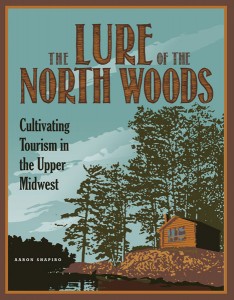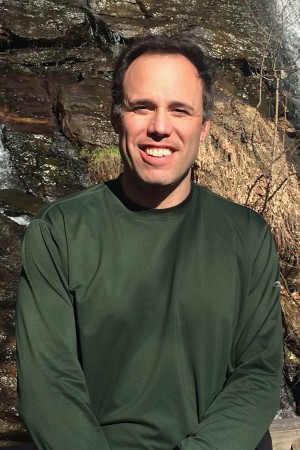UNC Charlotte historian Aaron Shapiro has received The Midwestern History Association’s annual Jon Gjerde Prize for the best book authored on a Midwestern history topic during a calendar year. The association awarded the prize for Shapiro’s book The Lure of the North Woods: Cultivating Tourism in the Upper Midwest (University of Minnesota Press, 2013.)
Shapiro is associate professor and director of Public History at UNC Charlotte. Shapiro received the prize on April 17 at the annual meeting of the Midwestern History Association in St. Louis, in conjunction with the Organization of American Historians annual meeting.
In his book Shapiro describes how residents and visitors reshaped the North Woods of Minnesota, Wisconsin, and Michigan from a hub of production supplying industrial America with vast quantities of lumber and mineral ore in the 19th century into a vacationland amongst woods and lakes in the 20th century. The rejuvenated North Woods profited in new ways by drawing on emerging connections between the urban and rural, including improved transportation, promotion, recreational land use, and conservation initiatives.
The book explores how this transformation is linked to the interwar origins of modern American environmentalism. At a time when travel and recreation are considered major economic forces, The Lure of the North Woods reveals how leisure—and tourism in particular—has shaped modern America.
“Shapiro’s work is a fine example of regional history and a sensitive examination of the rise of tourism as a trade catering to the needs and desires of ordinary people rather than the rich,” said Joseph Fitzharris, chairman of the award selection committee. “He combines good scholarship with good story-telling.”
Shapiro’s childhood days growing up in Chicago and spending time at summer camp in the North Woods shaped his interests. “I’ve always been a city kid, but I also find myself needing the forest—and not just the physicality of biking or hiking the trail and enjoying the trees and wildlife, but also the idea of the forest and what it represents,” he said.
“As a historian, it seemed natural to want to investigate how others had experienced and understood such places in the past,” he said. “I read William Cronon’s Nature’s Metropolis and not only was I mesmerized by his story of Chicago’s growth in the 19th century, but I wondered how the relationships and connections that developed between urban and rural worlds in the 19th century continued in the 20th century. The book begins to answer the question of how relationships and connections developed between urban and rural worlds.”
Getting Muddy and Digging Deep
To research and write the book, he took the advice of one of environmental history’s founders, Donald Worster, to buy a good pair of walking shoes and get them muddy. He also worked with “incredible archivists” in Minnesota, Michigan, Wisconsin and Ontario looking at old newspapers, promotional materials, hotel and lodging records, correspondence, state inspections and other documents.
Shapiro’s book bridges the past and present and may offer guidance for policymakers today.
 “It offers a reminder of how work and leisure are inseparable from nature—whether one is sitting in Atkins Library, walking in Uptown Charlotte, or traversing the woods of Western North Carolina,” he said. “Over the years, promoters marked the North Woods as an industrial behemoth, a land of agricultural plenty, a natural paradise, a rustic escape, and a vacation utopia. But, and I hope this lesson is clear from the book—as they have for centuries, it is the humans who inhabit place and the actions they take toward nature, each other, and the past that will continue to determine our future on this planet.”
“It offers a reminder of how work and leisure are inseparable from nature—whether one is sitting in Atkins Library, walking in Uptown Charlotte, or traversing the woods of Western North Carolina,” he said. “Over the years, promoters marked the North Woods as an industrial behemoth, a land of agricultural plenty, a natural paradise, a rustic escape, and a vacation utopia. But, and I hope this lesson is clear from the book—as they have for centuries, it is the humans who inhabit place and the actions they take toward nature, each other, and the past that will continue to determine our future on this planet.”
Shapiro has implemented his research findings into the classroom, such as by leading a guest session in history professor Karen Cox’s heritage tourism graduate seminar.
“One of the things we discussed was that regardless of whether one looks at the 1920s, 1960s, or the present, tourism has never offered a simple panacea for solving problems associated with deindustrialization and economic decline,” he said. “Today, cultural and heritage tourism is often used in attempts to revitalize rural areas and declining downtowns, but the results and outcomes are often mixed.”
While tourism can offer benefits, it also can foster new forms of exploitative labor and land use, he said.
Shapiro previously taught at Auburn University, where he launched the public history program. As national historian for the US Forest Service, he was previously involved with a variety of public history projects including films, websites, oral histories, interpretive planning, exhibit development, collections management, historic preservation, and heritage tourism initiatives. Before joining the Forest Service, Shapiro was assistant director of the Scholl Center for Family and Community History at Chicago’s Newberry Library.
Shapiro received his master’s and doctoral degrees in history from the University of Chicago and a bachelor’s degree in history from the University of Pennsylvania. He is particularly interested in questions regarding the intersection of people and place, changing perspectives of the cultural and natural landscape, and connections between memory, heritage, and public historical interpretation. His research explores questions about the history of land use and environmental change, modern environmental politics, the relationship between work and leisure, and broader cultural transformations in twentieth century urban and rural America.
The members of this year’s Gjerde Prize committee are Fitzharris of the University of St. Thomas; Greg Schneider of Emporia State University; and Margaret Sankey of Minnesota State University-Moorhead. The Gjerde Prize is named for University of California-Berkeley historian Jon Gjerde, who wrote extensively about the Midwest and its immigrant peoples.
Compiled and edited by Michael Eccles, Communications Student Assistant








